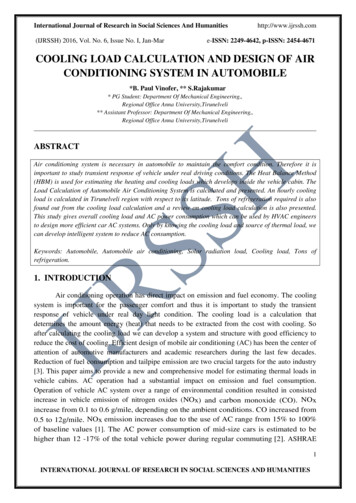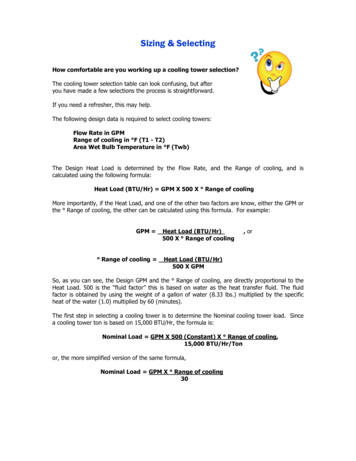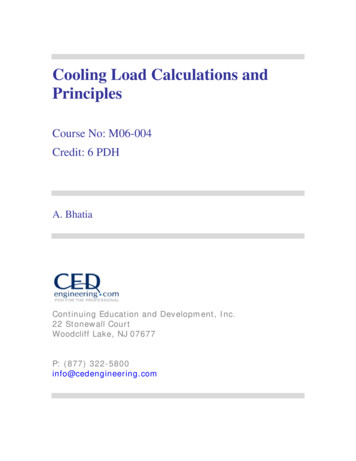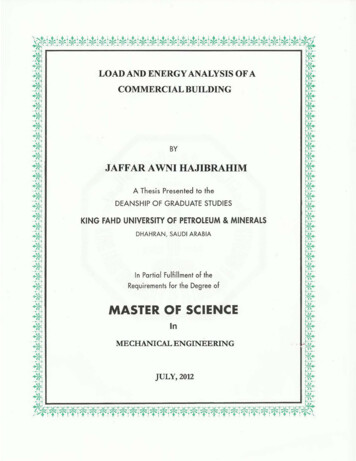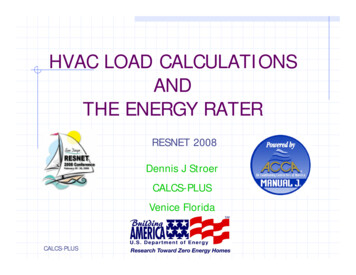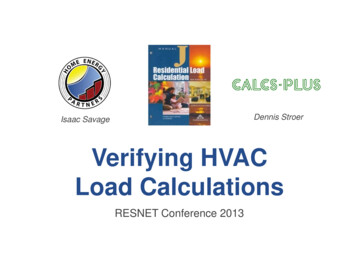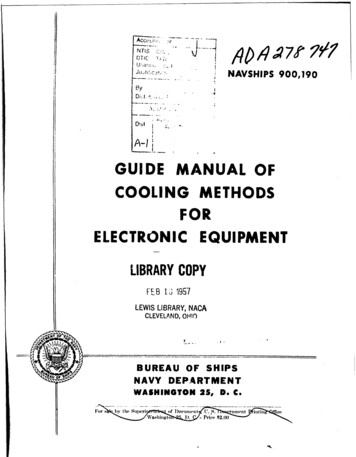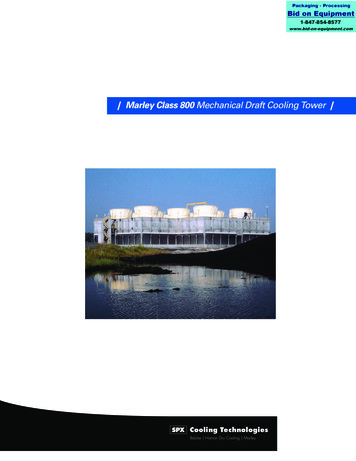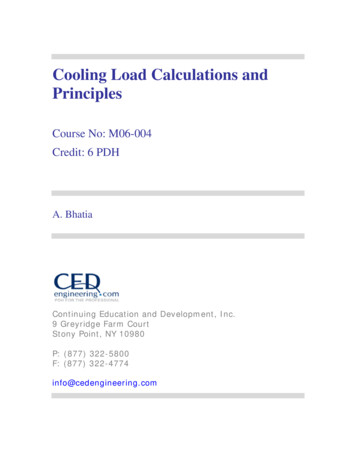
Transcription
Cooling Load Calculations andPrinciplesCourse No: M06-004Credit: 6 PDHA. BhatiaContinuing Education and Development, Inc.9 Greyridge Farm CourtStony Point, NY 10980P: (877) 322-5800F: (877) 322-4774info@cedengineering.com
HVAC COOLING LOAD CALCULATIONS AND PRINCIPLESTABLE OF CONTENTS1.0OBJECTIVE . 22.0TERMINOLOGY . 23.0SIZING YOUR AIR-CONDITIONING SYSTEM . 43.14.0HEATING LOAD V/S COOLING LOAD CALCULATIONS. 5HEAT FLOW RATES. 54.1SPACE HEAT GAIN. 64.2SPACE HEAT GAIN V/S COOLING LOAD (HEAT STORAGE EFFECT) . 74.3SPACE COOLING V/S COOLING LOAD (COIL). 85.0COMPONENTS OF COOLING LOAD . 86.0COOLING LOAD CALCULATION METHOD . 96.17.08.0DESIGN INFORMATION . 107.1OUTDOOR DESIGN WEATHER CONDITIONS . 107.2INDOOR DESIGN CONDITIONS AND THERMAL COMFORT. 127.3INDOOR AIR QUALITY AND OUTDOOR AIR REQUIREMENTS. 137.4BUILDING PRESSURIZATION . 137.5BUILDING CHARACTERISTICS . 147.6OPERATING SCHEDULES . 14COOLING LOAD METHODOLOGY – CONSIDERATIONS & ASSUMPTIONS . 148.19.0ACCURACY AND RELIABILITY OF VARIOUS CALCULATION METHODS. 9THERMAL ZONING . 15CLTD/SCL/CLF METHOD OF LOAD CALCULATION (ASHRAE FUNDAMENTALS 1997). 169.1EXTERNAL COOLING LOAD. 169.2INTERNAL COOLING LOADS. 259.3HEAT GAIN FROM MISCELLANEOUS SOURCES . 3010.0SUPPLY AIR CALCULATIONS . 3211.0EXAMPLE . 3312.013.011.1COOLING LOAD EXAMPLE IN US UNITS . 3311.2COOLING LOAD EXAMPLE IN METRIC UNITS . 53COMPUTER PROGRAMS. 5712.1ELITE CHVAC. 5712.2TRACE 700 . 59REFERENCES . 61Page 1 of 61
HVAC COOLING LOAD CALCULATIONS AND PRINCIPLES1.0OBJECTIVECooling load calculations may be used to accomplish one or more of the following objectives:a) Provide information for equipment selection, system sizing and system design.b) Provide data for evaluating the optimum possibilities for load reduction.c) Permit analysis of partial loads as required for system design, operation and control.This course provides a procedure for preparing a manual calculation for cooling load. A number of publishedmethods, tables and charts from industry handbooks, manufacturer’s engineering data and manufacturer’scatalog data usually provide a good source of design information and criteria in the preparation of the HVAC loadcalculation. It is not the intent of this course to duplicate this information but rather to extract appropriate datafrom these documents as well as provide a direction regarding the proper use or application of such data so thatengineers and designers involved in preparing the calculations can make the appropriate decision and/or applyproper engineering judgment.The course includes two example calculations for better understanding of the subject.2.0TERMINOLOGYCommonly used terms relative to heat transmission and load calculations are defined below in accordance withASHRAE Standard 12-75, Refrigeration Terms and Definitions.Space – is either a volume or a site without a partition or a partitioned room or group of rooms.Room – is an enclosed or partitioned space that is usually treated as single load.Zone – is a space or group of spaces within a building with heating and/or cooling requirements sufficiently similarso that comfort conditions can be maintained throughout by a single controlling device.British thermal unit (Btu) - is the approximate heat required to raise 1 lb. of water 1 deg Fahrenheit, from 590Fto 600F. Air conditioners are rated by the number of British Thermal Units (Btu) of heat they can remove per hour.Another common rating term for air conditioning size is the "ton," which is 12,000 Btu per hour and Watts. Somecountries utilize one unit, more than the others and therefore it is good if you can remember the relationshipbetween BTU/hr, Ton, and Watts. 1 ton is equivalent to 12,000 BTU/hr. and 12,000 BTU/hr is equivalent to 3,516 Watts - or 3.516 kW (kilo-Watts).Cooling Load Temperature Difference (CLTD) – an equivalent temperature difference used for calculating theinstantaneous external cooling load across a wall or roof.Page 2 of 61
HVAC COOLING LOAD CALCULATIONS AND PRINCIPLESSensible Heat Gain – is the energy added to the space by conduction, convection and/or radiation.Latent Heat Gain – is the energy added to the space when moisture is added to the space by means of vaporemitted by the occupants, generated by a process or through air infiltration from outside or adjacent areas.Radiant Heat Gain – the rate at which heat absorbed is by the surfaces enclosing the space and the objectswithin the space.Space Heat Gain – is the rate at which heat enters into and/or is generated within the conditioned spaceduring a given time interval.Space Cooling Load – is the rate at which energy must be removed from a space to maintain a constantspace air temperature.Space Heat Extraction Rate - the rate at which heat is removed from the conditioned space and is equal tothe space cooling load if the room temperature remains constant.Temperature, Dry Bulb – is the temperature of air indicated by a regular thermometer.Temperature, Wet Bulb – is the temperature measured by a thermometer that has a bulb wrapped in wetcloth. The evaporation of water from the thermometer has a cooling effect, so the temperature indicated bythe wet bulb thermometer is less than the temperature indicated by a dry-bulb (normal, unmodified)thermometer. The rate of evaporation from the wet-bulb thermometer depends on the humidity of the air.Evaporation is slower when the air is already full of water vapor. For this reason, the difference in thetemperatures indicated by ordinary dry bulb and wet bulb thermometers gives a measure of atmospherichumidity.Temperature, Dewpoint – is the temperature to which air must be cooled in order to reach saturation or atwhich the condensation of water vapor in a space begins for a given state of humidity and pressure.Relative humidity - describes how far the air is from saturation. It is a useful term for expressing theamount of water vapor when discussing the amount and rate of evaporation. One way to approachsaturation, a relative humidity of 100%, is to cool the air. It is therefore useful to know how much the airneeds to be cooled to reach saturation.Thermal Transmittance or Heat Transfer Coefficient (U-factor) – is the rate of heat flow through a unitarea of building envelope material or assembly, including its boundary films, per unit of temperaturedifference between the inside and outside air. The U-factor is expressed in Btu/ (hr 0F ft2).Thermal Resistance (R) – is the reciprocal of a heat transfer coefficient and is expressed in (hr 0F ft2)/Btu. Forexample, a wall with a U-value of 0.25 would have a resistance value of R 1/U 1/0.25 4.0. The value of R isalso used to represent Thermal Resistivity, the reciprocal of the thermal conductivity.Page 3 of 61
HVAC COOLING LOAD CALCULATIONS AND PRINCIPLES3.0SIZING YOUR AIR-CONDITIONING SYSTEMConcepts and fundamentals of air conditioner sizing is based on heat gain, and/or losses in a building. It isobvious that you will need to remove the amount of heat gain - if it is hot outside. Similarly, you'll need to add inthe heat loss from your space - if outside temperature is cold. In short, heat gain and loss, must be equallybalanced by heat removal, and addition, to get the desired room comfort that we want.The heat gain or heat loss through a building depends on:a. The temperature difference between outside temperature and our desired temperature.b. The type of construction and the amount of insulation is in your ceiling and walls. Let's say, that you havetwo identical buildings, one is build out of glass, and the other out of brick. Of course the one built withglass would require much more heat addition, or removal, compared to the other - given a same day. Thisis because the glass has a high thermal conductivity (U-value) as compared to the brick and alsobecause it is transparent, it allows direct transmission of solar heat.c.How much shade is on your building’s windows, walls, and roof? Two identical buildings with differentorientation with respect to the direction of sun rise and fall will also influence the air conditioner sizing.d. How large is your room? The surface area of the walls. The larger the surface area - the more heat canloose, or gain through it.e. How much air leaks into indoor space from the outside? Infiltration plays a part in determining our airconditioner sizing. Door gaps, cracked windows, chimneys - are the "doorways" for air to enter fromoutside, into your living space.f.The occupants. It takes a lot to cool a town hall full of people.g. Activities and other equipment within a building. Cooking? Hot bath? Gymnasium?h. Amount of lighting in the room. High efficiency lighting fixtures generate less heat.i.How much heat the appliances generate. Number of power equipments such as oven, washing machine,computers, TV inside the space; all contribute to heat.The air conditioner's efficiency, performance, durability, and cost depend on matching its size to the abovefactors. Many designers use a simple square foot method for sizing the air-conditioners. The most common rule ofthumb is to use "1 ton for every 500 square feet of floor area". Such a method is useful in preliminary estimationof the equipment size. The main drawback of rules-of-thumb methods is the presumption that the building designwill not make any difference. Thus the rules for a badly designed building are typically the same as for a gooddesign.It is important to use the correct procedure for estimating heat gain or heat loss. Two groups—the AirConditioning Contractors of America (ACCA) and the American Society of Heating, Refrigerating, and AirConditioning Engineers (ASHRAE)—publish calculation procedures for sizing central air conditioners.Page 4 of 61
HVAC COOLING LOAD CALCULATIONS AND PRINCIPLESReputable air conditioning contractors will use one of these procedures, often performed with the aid of acomputer, to size your new central air conditioner.3.1Heating Load V/s Cooling Load CalculationsAs the name implies, heating load calculations are carried out to estimate the heat loss from the building in winterso as to arrive at required heating capacities. Normally during winter months the peak heating load occurs beforesunrise and the outdoor conditions do not vary significantly throughout the winter season. In addition, internal heatsources such as occupants or appliances are beneficial as they compensate some of the heat losses. As a result,normally, the heat load calculations are carried out assuming steady state conditions (no solar radiation andsteady outdoor conditions) and neglecting internal heat sources. This is a simple but conservative approach thatleads to slight overestimation of the heating capacity. For more accurate estimation of heating loads, one has totake into account the thermal capacity of the walls and internal heat sources, which makes the problem morecomplicated.For estimating cooling loads, one has to consider the unsteady state processes, as the peak cooling load occursduring the day time and the outside conditions also vary significantly throughout the day due to solar radiation. Inaddition, all internal sources add on to the cooling loads and neglecting them would lead to underestimation of therequired cooling capacity and the possibility of not being able to maintain the required indoor conditions. Thuscooling load calculations are inherently more complicated.In determining the heating load, credit for solar heat gain or internal heat gains is usually NOT included andthe thermal storage effects of building structure are generally ignored. Whereas in cooling load calculations,the thermal storage characteristics of the building play a vital role because the time at which the space mayrealize the heat gain as a cooling load will be considerably offset from the time the heat started to flow.We will discuss this further in succeeding sections.4.0HEAT FLOW RATESIn air-conditioning design, four related heat flow rates, each of which varies with time, must be differentiated:a. Space heat gain ----------------How much heat (energy) is entering the space?b. Space cooling load -------------How much energy must be removed from the space to keep temperatureand relative humidity constant?c.Space heat extraction-----------How much energy is the HVAC removing from the space?d. Cooling load (coil) ---------------How much energy is removed by the cooling coil serving various spacesplus any loads external to the spaces such as duct heat gain, duct leakage, fan heat and outdoor makeupair?Page 5 of 61
HVAC COOLING LOAD CALCULATIONS AND PRINCIPLES4.1Space Heat GainThis instantaneous rate of heat gain is the rate at which heat enters into and/or is generated within a space at agiven instant. Heat gain is classified by:The manner in which it enters the space –a. Solar radiation through transparent surfaces such as windowsb. Heat conduction through exterior walls and roofsc.Heat conduction through interior partitions, ceilings and floorsd. Heat generated within the space by occupants, lights, appliances, equipment and processese. Loads as a result of ventilation and infiltration of outdoor airf.Other miscellaneous heat gainsWhether it is a sensible or latent gain –Sensible heat - Heat which a substance absorbs, and while its temperature goes up, the substance does notchange state. Sensible heat gain is directly added to the conditioned space by conduction, convection, and/orradiation. Note that the sensible heat gain entering the conditioned space does not equal the sensible coolingload during the same time interval because of the stored heat in the building envelope. Only the convective heatbecomes cooling load instantaneously. Sensible heat load is total ofa. Heat transmitted thru floors, ceilings, wallsb. Occupant’s body heatc.Appliance & Light heatd. Solar Heat gain thru glasse. Infiltration of outside airf.Air introduced by VentilationLatent Heat Loads - Latent heat gain occurs when moisture is added to the space either from internal sources(e.g. vapor emitted by occupants and equipment) or from outdoor air as a result of infiltration or ventilation tomaintain proper indoor air quality. Latent heat load is total ofa. Moisture-laden outside air form Infiltration & Ventilationb. Occupant Respiration & ActivitiesPage 6 of 61
HVAC COOLING LOAD CALCULATIONS AND PRINCIPLESc.Moisture from Equipment & AppliancesTo maintain a constant humidity ratio, water vapor must condense on cooling apparatus at a rate equal to its rateof addition into the space. This process is called dehumidification and is very energy intensive, for instance,removing 1 kg of humidity requires approximately 0.7 kWh of energy.4.2Space Heat Gain V/s Cooling Load (Heat Storage Effect)Space Heat Gain is to Space Cooling LoadThe heat received from the heat sources (conduction, convection, solar radiation, lightning, people, equipment,etc.) does not go immediately to heating the room air. Only some portion of it is absorbed by the air in theconditioned space instantaneously leading to a minute change in its temperature. Most of the radiation heatespecially from sun, lighting, people is first absorbed by the internal surfaces, which include ceiling, floor, internalwalls, furniture etc. Due to the large but finite thermal capacity of the roof, floor, walls etc., their temperatureincreases slowly due to absorption of radiant heat. The radiant portion introduces a time lag and also a decrementfactor depending upon the dynamic characteristics of the surfaces. Due to the time lag, the effect of radiation willbe felt even when the source of radiation, in this case the sun is removed.Differences between Space Heat Gain and Space Cooling LoadDifferences between instantaneous heat gain and cooling load is due to heat storage affect.The relation between heat gain and cooling load and the effect of the mass of the structure (light, medium &heavy) is shown below. From the figure it is evident that, there is a delay in the peak heat, especially for heavyconstruction.Page 7 of 61
HVAC COOLING LOAD CALCULATIONS AND PRINCIPLES4.3Space Cooling V/s Cooling Load (Coil)Space cooling is the rate at which heat must be removed from the spaces to maintain air temperature at aconstant value. Cooling load, on the other hand, is the rate at which energy is removed at the cooling coil thatserves one or more conditioned spaces in any central air conditioning system. It is equal to the instantaneoussum of the space cooling loads for all spaces served by the system plus any additional load imposed on thesystem external to the conditioned spaces items such as fan energy, fan location, duct heat gain, duct leakage,heat extraction lighting systems and type of return air systems all affect component sizing.5.0COMPONENTS OF COOLING LOADThe total building cooling load consists of heat transferred through the building envelope (walls, roof, floor,windows, doors etc.) and heat generated by occupants, equipment, and lights. The load due to heat transferthrough the envelope is called as external load, while all other loads are called as internal loads. Thepercentage of external versus internal load varies with building type, site climate, and building design. The totalcooling load on any building consists of both sensible as well as latent load components. The sensible loadaffects the dry bulb temperature, while the latent load affects the moisture content of the conditioned space.Buildings may be classified as externally loaded and internally loaded. In externally loaded buildings the coolingload on the building is mainly due to heat transfer between the surroundings and the internal conditioned space.Since the surrounding conditions are highly variable in any given day, the cooling load of an externally loadedbuilding varies widely. In internally loaded buildings the cooling load is mainly due to internal heat generatingsources such as occupants, lights or appliances. In general the heat generation due to internal heat sources mayremain fairly constant, and since the heat transfer from the variable surroundings is much less compared to theinternal heat sources, the cooling load of an internally loaded building remains fairly constant. Obviously fromenergy efficiency and economics points of view, the system design strategy for an externally loaded buildingPage 8 of 61
HVAC COOLING LOAD CALCULATIONS AND PRINCIPLESshould be different from an internally loaded building. Hence, prior knowledge of whether the building is externallyloaded or internally loaded is essential for effective system design.6.0COOLING LOAD CALCULATION METHODFor a thorough calculation of the zones and whole-building loads, one of the following three methods should beemployed:a. Transfer Function Method (TFM): This is the most complex of the methods proposed by ASHRAE andrequires the use of a computer program or advanced spreadsheet.b. Cooling Load Temperature Differential/Cooling Load Factors (CLTD/CLF): This method is derived fromthe TFM method and uses tabulated data to simplify the calculation process. The method can be fairlyeasily transferred into simple spreadsheet programs but has some limitations due to the use of tabulateddata.c.Total Equivalent Temperature Differential/Time-Averaging (TETD/TA): This was the preferred method forhand or simple spreadsheet calculation before the introduction of the CLTD/CLF method.These three methods are well documented in ASHRAE Handbook Fundamentals, 2001.6.1Accuracy and Reliability of Various Calculation MethodsFor each cooling load calculation method, there are several benefits/limitations which feature each method.Simplicity and accuracy are two contradicting objectives to be fulfilled. If a method could be considered tobe simple, its accuracy would be a matter of question, and vice versa.While modern methods emphasize on improving the procedure of calculating solar and conduction heatgains, there are also other main sources coming from internal heat gains (people, lighting and equipment).Page 9 of 61
HVAC COOLING LOAD CALCULATIONS AND PRINCIPLESHandbooks include tables for the heat gain estimations from the internal sources. However, such tables areincomplete. For example, for equipment not mentioned in the tables, only limited information is indicatedabout them. Sometimes recommendations are mentioned about using 25% to 50% of the nameplate powerconsumption, where the final value is left to the interpretation of the designer. In other times it is theaccurate predictability of the occurrence is also important, e.g. the frequency of using of equipment is veryimportant to determine the heat gain. This example for internal heat gain shows that, when thinking aboutaccuracy, it is not only the method (simple vs. complex) which is effective, but uncertainties in the input dataare also important.There are high degrees of uncertainty in input data required to determine cooling loads. Much of this is dueto the unpredictability of occupancy, human behavior, outdoors weather variations, lack of and variation inheat gain data for modern equipments, and introduction of new building products and HVAC equipmentswith unknown characteristics. These generate uncertainties that far exceed the errors generated by simplemethods compared to more complex methods. Therefore, the added time/effort required for the morecomplex calculation methods would not be productive in terms of better accuracy of the results ifuncertainties in the input data are high. Otherwise, simplified methods would, likely, have a similar level ofsatisfactory accuracy.For strictly manual cooling load calculation method, the most practical to use is the CLTD/SCL/CLF methodas described in the 1997 ASHRAE Fundamentals. This method, although not optimum, will yield the mostconservative results based on peak load values to be used in sizing equipment. It should be noted that theresults obtained from using the CLTD/CLF method depend largely on the characteristics of the space beingconsidered and how they vary from the model used to generate the CLTD/CLF data shown on the varioustables. Engineering judgment is required in the interpretation of the custom tables and applying appropriatecorrection factors.7.0DESIGN INFORMATIONTo calculate the space cooling load, detailed building information, location, site and weather data, internal designinformation and operating schedules are required. Information regarding the outdoor design conditions anddesired indoor conditions are the starting point for the load calculation and is discussed below.7.1Outdoor Design Weather ConditionsASHRAE Handbook 1993 Fundamentals (Chapter 26) list tables of climate conditions for the US, Canada andother International locations: In these tables:The information provided in table 1a, 2a and 3a are for heating design conditions that include:a. Dry bulb temperatures corresponding to 99.6% and 99% annual cumulative frequency of occurrence,Page 10 of 61
HVAC COOLING LOAD CALCULATIONS AND PRINCIPLESb. Wind speeds corresponding to 1%, 2.5% and 5% annual cumulative frequency of occurrence,c.Wind direction most frequently occurring with 99.6% and 0.4% dry-bulb temperatures andd. Average of annual extreme maximum and minimum dry-bulb temperatures and standard deviations.The information provided in table 1b, 2b and 3b are for cooling and humidity control conditions that include:a. Dry bulb temperature corresponding to 0.4%, 1.0% and 2.0% annual cumulative frequency of occurrenceand the mean coincident wet-bulb temperature (warm). These conditions appear in sets of dry bulb (DB)temperature and the mean coincident wet bulb (MWB) temperature since both values are needed todetermine the sensible and latent (dehumidification) loads in the cooling mode.b. Wet-bulb temperature corresponding to 0.4%, 1.0% and 2.0% annual cumulative frequency of occurrenceand the mean coincident dry-bulb temperaturec.Dew-point temperature corresponding to 0.4%, 1.0% and 2.0% annual cumulative frequency ofoccurrence and the mean coincident dry-bulb temperature and humidity ratio (calculated for the dew-pointtemperature at the standard atmospheric pressure at the elevation of the station).d. Mean daily range (DR) of the dry bulb temperature, which is the mean of the temperature differencebetween daily maximum and minimum temperatures for the warmest month (highest average dry-bulbtemperature). These are used to correct CLTD values.In choosing the HVAC outdoor design conditions, it is neither economical nor practical to design equipment eitherfor the annual hottest temperature or annual minimum temperature, since the peak or the lowest temperaturesmay occur only for a few hours over the span of several years. Economically speaking short duration peaks abovethe system capacity might be tolerated at significant reductions in first cost; this is a simple risk - benefit decisionfor each building design.Therefore, as a practice, the ‘design temperature and humidity’ conditions are based on frequency of occurrence.The summer design conditions have been presented for annual percentile values of 0.4, 1 and 2% and wintermonth conditions are based on annual percentiles of 99.6 and 99%. The term “design condition” refers to the%age of time in a year (8760 hours), the values of dry-bulb, dew-point and wet-bulb temperature exceed by theindicated percentage. The 0.4%, 1.0%, 2.0% and 5.0% values are exceeded on average by 35, 88, 175 and 438hours.The 99% and 99.6% cold values are defined in the same way but are viewed as the values for which thecorresponding weather element are less than the design condition 88 and 35 hours, respectively. 99.6% valuesuggests that the outdoor temperature is equal to or lower than design data 0.4% of the time.Design condition is used to calculate maximum heat gain and maximum heat loss of the building. For comfortcooling, use of the 2.5% occurrence and for heating use of 99% values is recommended. The 2.5% designcondition means that the outside summer temperature and coincident
Cooling load calculations may be used to accomplish one or more of the following objectives: a) Provide information for equipment selection, system sizing and system design. b) Provide data for evaluating the optimum possibilities for load reduction. c) Permit analysis of partial loads as required for system design, operation and control. .
